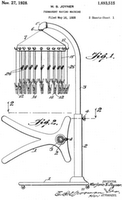Public History and Material Culture:Engaging the Next Generation

Our visit to Museum London and this week’s class readings in 500f made me think about how we will create an exhibit that will engage the public. The artifacts which have been chosen already go a long way in terms of creating interest. I mean the ‘Permanent Wave Machine’ looks like some medieval torture device. When there was discussion of outreach programs, mainly to school groups, I saw this as a perfect opportunity to get the younger generation ‘pumped’ about history.
Material Culture- the study through artifacts of the belief system of a society across time is the basis for engaging a new generation in the study of history. Of course, like Pursell says, “ it is not enough to just display and identify the objects,” you also have to promote the ideas which are related to the objects. Interpretation is the key to understanding the past and the artifacts.[1] There may be more of an understanding by the younger generation if technological items are displayed and if technology is used in the exhibit. Video, audio, and computer enhancements are ideal in presenting history to a younger generation. I’m sure many history purists would disagree, but as a Public Historian in the 21st century, I recognize the need to keep pace technologically, not only in the virtual realm but in the museums themselves.
In Schlereth’s article“Material Culture and Cultural Research,” he discusses
 the need to have exhibits which employ material culture evidence which changes or revises historical interpretations.[2] He also discusses the need to be innovative in communicating knowledge to the public. I think this is vastly important. We live in a society where people can access information instantaneously. The next generation is being raised on ipods and Playstation. In order for history and museums to remain relevant, they have to engage that segment of society which will be the next audience.
the need to have exhibits which employ material culture evidence which changes or revises historical interpretations.[2] He also discusses the need to be innovative in communicating knowledge to the public. I think this is vastly important. We live in a society where people can access information instantaneously. The next generation is being raised on ipods and Playstation. In order for history and museums to remain relevant, they have to engage that segment of society which will be the next audience.Of course online exhibits and fledgling tagging projects will do a lot to interest the younger generation, but what do we show them when they actually come to the museum? We show them things which will be relevant to them..We tell real stories. Laurel Thatcher Ulrich’s “Hannah Barnard’s Cupboard”[3] shows the difficulty of historical interpretation but also shows the relevance of an everyday item in defining what a past society was like. She reveals how identities and socio-economic class can be discovered from a single object.
Kyvig and Marty note that every person’s world has a history which is useful and exciting.[4] This idea of studying ‘Nearby History’ allows an understanding of one’s immediate past which gives a person the tools to place him or herself in the ‘big’ picture. They are able to ask and potentially answer the question ‘how do I relate to what has happened in the past and what is going on in the world?’ An individual can develop research skills doing nearby history and cultivate the critical thinking skills to deal with a variety of situation.
A museum exhibit then should use artifacts from the past and arrange and display them such that they have meaning in the present. After all, the exhibit is created for a contemporary audience and their needs should be considered if historians hope to engage a new generation in the appreciation of history.
1. Carroll W Pursell Jr., “The History of Technology and the Study of Material Culture,” from Material Culture: A Research Guide (University Press of Kansas)
2. Thomas J Schlereth, “Material Culture and Cultural Research,” from Material Culture: A Ressearch Guide (University Press of Kansas, 1985)
3. Laurel Thatcher Ulrich, “Hannah Barnard’s Cupboard,” from The Age of Homespun: Objects and Stories in the Creation of an American Myth (New York: Vintage Books, 2001)
4. David E Kyvig and Myron A Marty, “Why Nearby History,” Nearby History: Exploring the Past Around You, 2nd ed. (Walnut Creek, Ca.: Altamira Press, 2000)

1 Comments:
It's great that you remind us of Pursell's comment that it's not enough to just display objects, but that we must also promote the ideas linked to them. In light of that important concept, your idea to include current technological "artefacts" is a great one, I think! It would really "bring it home" to a teenager if she were to see an ipod juxtaposed with an old gramophone, or something like that. An incorporation of our "ordinary" objects of today into an exhibit would really work to convey, as you say, a sense that every person's world has a history that is useful and exciting!
Thanks, Kelly - your blog made me think in different ways about the relationship between people and their stuff.
Post a Comment
<< Home